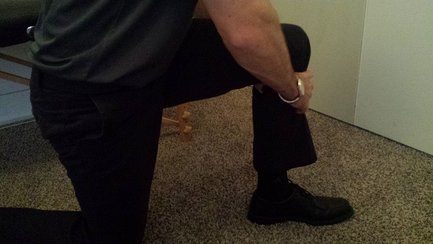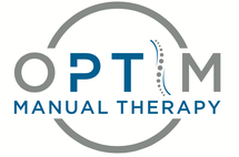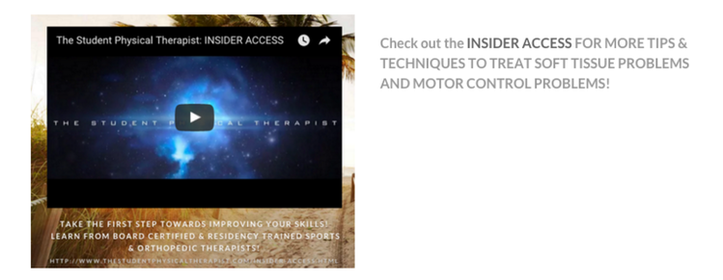- Home
- About Us
- TSPT Academy
- Online Courses
-
Resources
- Newsletter
- Business Minded Sports Physio Podcast
- Day in the Life of a Sports PT
- Residency Corner
-
Special Tests
>
-
Cervical Spine
>
- Alar Ligament Test
- Bakody's Sign
- Cervical Distraction Test
- Cervical Rotation Lateral Flexion Test
- Craniocervical Flexion Test (CCFT)
- Deep Neck Flexor Endurance Test
- Posterior-Anterior Segmental Mobility
- Segmental Mobility
- Sharp-Purser Test
- Spurling's Maneuver
- Transverse Ligament Test
- ULNT - Median
- ULNT - Radial
- ULNT - Ulnar
- Vertebral Artery Test
- Thoracic Spine >
-
Lumbar Spine/Sacroiliac Joint
>
- Active Sit-Up Test
- Alternate Gillet Test
- Crossed Straight Leg Raise Test
- Extensor Endurance Test
- FABER Test
- Fortin's Sign
- Gaenslen Test
- Gillet Test
- Gower's Sign
- Lumbar Quadrant Test
- POSH Test
- Posteroanterior Mobility
- Prone Knee Bend Test
- Prone Instability Test
- Resisted Abduction Test
- Sacral Clearing Test
- Seated Forward Flexion Test
- SIJ Compression/Distraction Test
- Slump Test
- Sphinx Test
- Spine Rotators & Multifidus Test
- Squish Test
- Standing Forward Flexion Test
- Straight Leg Raise Test
- Supine to Long Sit Test
-
Shoulder
>
- Active Compression Test
- Anterior Apprehension
- Biceps Load Test II
- Drop Arm Sign
- External Rotation Lag Sign
- Hawkins-Kennedy Impingement Sign
- Horizontal Adduction Test
- Internal Rotation Lag Sign
- Jobe Test
- Ludington's Test
- Neer Test
- Painful Arc Sign
- Pronated Load Test
- Resisted Supination External Rotation Test
- Speed's Test
- Posterior Apprehension
- Sulcus Sign
- Thoracic Outlet Tests >
- Yergason's Test
- Elbow >
- Wrist/Hand >
- Hip >
- Knee >
- Foot/Ankle >
-
Cervical Spine
>
- I want Financial Freedom
- I want Professional Growth
- I want Clinical Mastery
|
Those familiar with implementation of repeated motions are likely familiar with the benefit of using tibial internal rotation (IR) to improve lower quarter dysfunction. However, the majority of clinicians associate press-ups with repeated motions and are unaware of how to use the technique with the extremities. Each joint has a "common reset" that can be used to improve both pain and mobility. These patterns are based on common dysfuntional presentations but are by no means a rule. While the majority of injuries will respond to some sore of repeated motion, it may take time and there are some occasions where a joint may not respond. One of the common resets for the knee is tibial IR. As many of you are aware, the arthrokinematics of the knee include tibial rotation during sagittal plane motion. As the knee extends, there is a slight ER of the tibia that occurs to help lock it out. As the knee flexes, the tibial slightly internally rotates. When injury occurs to the knee, we often see a loss of one of these rotation motions as either end-range knee flexion or extension is affected. Thus, the repeated motion for limited tibial IR is closed-kinetic chain (CKC) knee flexion repeatedly while manual overpressure is applied into IR. While this exercise is obviously beneficial for knee disorders, it can also be implemented with foot/ankle dysfunction. Limited CKC ankle DF has been shown to be associated with excessive tibial external rotation (Rabin et al, 2016). This likely being associated with limited tibial IR mobility. Utilizing this same exercise (or something that similarly addresses decreased tibial IR) for limited ankle DF ROM can improve functional CKC mobility. Part of the reason for this benefit may be due to abnormal foot/ankle movement patterns. For example, take a look at an excessively prontated foot. As this ankle moves into DF, the motion prefers to come from the talonavicular joint or somewhere distal. This pattern leads to an abnormal utilization of tibial internal rotation at the knee. By maintaining subtalar neutral while moving into CKC DF with tibial IR overpressure, we may theoreticlly be mobilizing part of the talocrural capsule that is typically restricted and forcing a prontation motion. With the association shown between limited ankle DF mobility and hip/knee problems, it is well worth examination in all lower quarter patients. Try checking your patients ankle DF mobility in CKC for the next couple weeks and look for any abnormal movement patterns. See if you start to notice some patterns. -Dr. Chris Fox, PT, DPT, OCS Reference: Rabin A, Portnoy S, Kozol Z. (2016). The Association of Ankle Dorsiflexion Range of Motion With Hip and Knee Kinematics During the Lateral Step-down Test. J Orthop Sports Phys Ther. 2016 Nov;46(11):1002-1009.
4 Comments
dk
12/9/2016 12:01:46 pm
Great post. How do you determine limited tibial IR? How much tibial IR is "normal"?
Reply
Hi DK,
Reply
4/14/2024 04:19:12 am
Repeated tibial internal rotation (IR) can prove beneficial for individuals with limited knee and ankle mobility. This technique, akin to the interlocking pattern of Chevron wood flooring, aims to enhance joint flexibility and function. By repetitively engaging in tibial IR exercises, the surrounding musculature and ligaments gradually adapt, improving range of motion and reducing stiffness. Moreover, this targeted approach aids in proprioception, enhancing balance and stability, crucial for activities of daily living and sports performance. Incorporating repeated tibial IR into rehabilitation protocols can foster comprehensive joint health and functional outcomes, reminiscent of the intricate yet resilient structure of Chevron wood flooring.
Reply
4/30/2024 04:11:54 am
For individuals with limited knee and ankle mobility, adaptive tools become essential allies. From ergonomic canes to specialized footwear, these aids facilitate daily activities and enhance mobility. Moreover, low-impact exercises like swimming and cycling offer gentle workouts while minimizing strain on joints. Additionally, physiotherapy programs tailored to strengthen surrounding muscles provide crucial support. Another avenue is the use of assistive devices like knee braces and orthotics, offering stability and comfort. In social settings, the presence of a strolling magician or walk-around magician can provide entertainment without necessitating prolonged standing or walking, catering to diverse mobility needs with inclusivity and creativity.
Reply
Leave a Reply. |
Dr. Brian Schwabe's NEW Book in partner with PaleoHacks!
Learn residency-level content on our
Insider Access pages We value quality PT education & CEU's. Click the MedBridge logo below for TSPT savings!Archives
July 2019
Categories
All
|










 RSS Feed
RSS Feed